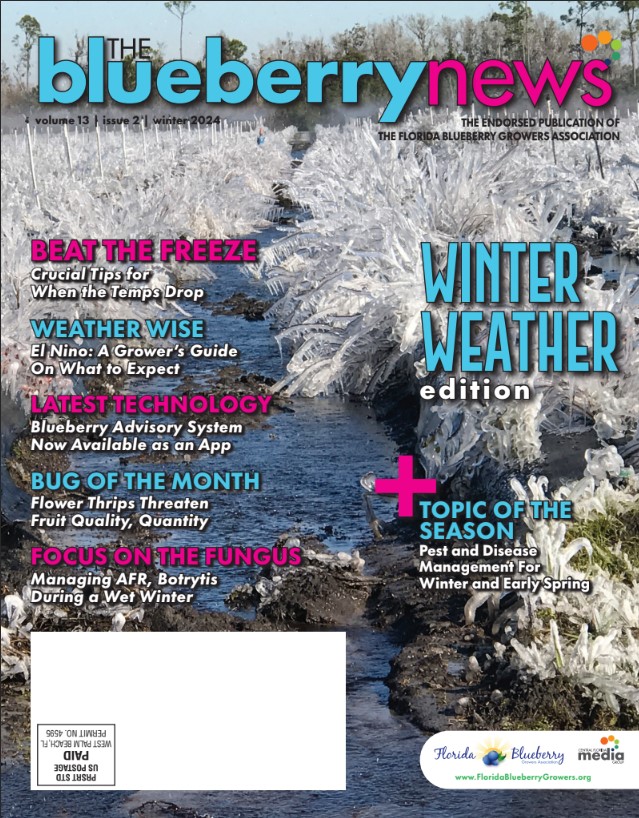Fall and Early Winter Bring Threat of Southern Red Mite and Blueberry Gall Midge
Two of the primary pests typically observed on southern highbush blueberries in Florida during the fall and early winter months are southern red mites and blueberry gall midge.
Southern Red Mite
The southern red mite is a type of spider mite that is usually found in higher numbers when conditions are warm and dry. Populations tend to peak during October through early November when rainfall has decreased but temperatures remain somewhat elevated (optimal temperatures are between 60 and 86°F). Their life cycle can be completed within two weeks under these conditions, and overlapping generations can occur under temperatures between 70 and 81°F, when populations can double within five days.
Southern red mite adults are about 0.015 inches in length and are red or brown to deep purple in color, with lighter-colored legs (Figure 1). Females are slightly larger than males and have a more rounded body shape in the posterior, compared to the slender body of the males. Eggs are red to brown and spherical. Eggs hatch into pale, six-legged larvae, while the nymphal stages have eight legs and become progressively darker and larger.
Figure 1. Adult southern red mites
Credits: O. Liburd, UF/IFAS
The primary symptom associated with southern red mite injury is leaf bronzing (Figure 2), due to internal leaf damage from the mites inserting their mouthparts into the leaf and removing cell contents. This damage can result in a decrease in the rate of photosynthesis. The degree of bronzing is proportional to the amount of internal leaf damage from mite feeding. These mites primarily infest the lower side of the leaves, resulting in the accumulation of white shed skins when populations reach high numbers (Figure 3) and produce a protective web made of silk over the infested surface to protect them from predators.
Figure 2. Bronzed leaf symptoms from mite feeding
Credits: D. Phillips, UF/IFAS
Figure 3. Shed mite skins on the underside of leaf
Credits: D. Phillips, UF/IFAS
Frequent scouting is recommended to identify early mite infestations during vegetative growth. Southern red mites can be seen with a 10X hand lens. While characteristic symptoms of mite feeding such as bronzed leaves are a good indication of mite infestations, these symptoms generally appear after moderate to severe infestation levels have already occurred and the risk of defoliation is high. Closely examine the underside of leaves to look for adults, shed skins, and webbing to detect the presence of the southern red mite. Growers can also sharply tap foliage onto a sheet of white paper to observe any adults.
Three miticides— Magister® with the active ingredient fenazaquin, Portal® with the active ingredient fenpyroximate, and Kanemite® with the active ingredient acequinocyl —have been registered for use in highbush blueberries. The miticides control all developmental stages including larvae, nymphs, and adults of southern red mites. Growers can only make one application per year using Magister® and two applications each per year with Portal® and Kanemite®.
Blueberry Gall Midge
The blueberry gall midge (BGM) is a small fly native to North America that feeds on blueberries. In Florida, its larvae feed on floral and vegetative buds of southern highbush blueberry.
Adult BGM are somewhat smaller than a mosquito, about 0.08 to 0.1 inches (females are larger than males) (Figure 1). The adult lives for only two to three days and becomes active when temperatures are warmer than 60°F. It is believed that mild winters characterized by cool and warm spells can result in higher midge activity. In Central Florida, adults typically become active in late fall (November to December), and peak activity appears to be in January and February. In North Central Florida, adults are active in November; however, cool temperatures in December and early January can reduce midge populations. Peak activity in North Central Florida occurs from late February to March. A single female can lay as many as 15 eggs per bud, forcing its ovipositor between the folds of flower and leaf buds just after bud swell when scales begin to separate. Eggs hatch in two to three days into young larvae that are difficult to observe within the buds. The larvae are translucent to white for the first three to five days, eventually turning orange when they mature in about eight to 10 days (Figure 2). The larvae pass through three stages and during this time feed on the inside of floral and vegetative buds. The larvae then drop to the ground to pupate in the soil before emerging as adults. It is believed that adult males usually emerge about two weeks before adult females.
Figure 1. Adult blueberry gall midge.
Credits: O. Liburd, UF/IFAS
Figure 2. Larval blueberry gall midge.
Credits: O. Liburd, UF/IFAS
BGM larvae feed on the inside of floral bud tissues, resulting in necrosis, brown lesions, and bud abortion, with accompanying poor fruit set. With significant gall midge damage, there will typically be a lighter bloom since many of these buds will abort (e.g., only 1 or 2 florets may be seen instead of the usual 5 to 6, and therefore fruit clusters will produce only 1 or 2 berries per cluster). It should be noted that damage to flower buds (such as browning, shriveling, and disintegration) can also be caused by hydrogen cyanamide over-application or freeze damage. Poor fruit set and excessive dropping of undeveloped green fruit can also be caused by poor pollination.
BGM larvae are difficult to kill using contact insecticides because they are protected while inside the buds. Contact insecticide applications must be timed to kill adults before they lay eggs. Careful scouting and monitoring should be conducted to time insecticide sprays to kill adults early in the season. This can be done using clear sticky traps hung on the sides of blueberry bushes close to the ground, or by placing a white bucket trap with a sticky Plexiglas top under bushes in direct contact with soil or pine bark to detect new adults emerging from the ground (3–5 traps per acre). Recommended chemical controls should be used when two or more adults are present in the traps. At a minimum, monitoring for larvae should be done by placing young stems with buds into a Ziploc-type plastic bag at room temperature. If present, larvae will begin to emerge after three to four days. If traps are not used for monitoring, preventive spray applications can be made. The first application should be made right before floral bud break, with a second application 10 days later.
Two insecticides that have shown effectiveness against gall midge are Exirel® with the active ingredient Cyazypyr®, and Movento® with the active ingredient Spirotetramat. These insecticides have systemic and translaminar activity that can target both larvae in floral and leaf buds and adults but cannot be used when pollinators are present. Neonicotinoids such as Assail® and Admire Pro® (imidacloprid) also have systemic activity and can kill larvae that are hidden between the bud scales but cannot be used when pollinators are present. The reduced-risk pesticide Delegate® (Spinetoram) is used for gall midge management when pollinators are present in the field. Once it has dried for 3 hours it has limited effects on bees. Delegate® will kill adult midges if it comes into contact with the adults; however, it has relatively short residual activity and will need to be re-applied weekly. Because adults live for such a short time (two to three days) the chances of this pesticide being effective against midges are greatly reduced. Please read the label and follow all directions for rates, frequency of application, and restrictions for all pesticides.
CREDITS:
Dr. Oscar Liburd, professor, UF/IFAS
& Doug Phillips, blueberry extension coordinator, UF/IFAS





